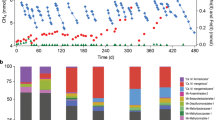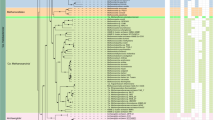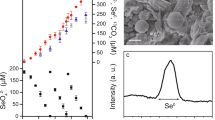Abstract
Anaerobic oxidation of methane (AOM) in marine sediments is an important microbial process in the global carbon cycle and in control of greenhouse gas emission. The responsible organisms supposedly reverse the reactions of methanogenesis1,2,3,4,5,6,7,8, but cultures providing biochemical proof of this have not been isolated. Here we searched for AOM-associated cell components in microbial mats from anoxic methane seeps in the Black Sea9,10,11. These mats catalyse AOM rather than carry out methanogenesis. We extracted a prominent nickel compound displaying the same absorption spectrum as the nickel cofactor F430 of methyl-coenzyme M reductase, the terminal enzyme of methanogenesis12; however, the nickel compound exhibited a higher molecular mass than F430. The apparent variant of F430 was part of an abundant protein that was purified from the mat and that consists of three different subunits. Determined amino-terminal amino acid sequences matched a gene locus cloned from the mat. Sequence analyses revealed similarities to methyl-coenzyme M reductase from methanogenic archaea. The abundance of the nickel protein (7% of extracted proteins) in the mat suggests an important role in AOM.
This is a preview of subscription content, access via your institution
Access options
Subscribe to this journal
Receive 51 print issues and online access
$199.00 per year
only $3.90 per issue
Buy this article
- Purchase on Springer Link
- Instant access to full article PDF
Prices may be subject to local taxes which are calculated during checkout



Similar content being viewed by others
References
Zehnder, A. J. B. & Brock, T. D. Methane formation and methane oxidation by methanogenic bacteria. J. Bacteriol. 137, 420–432 (1979)
Hoehler, T. M., Alperin, M. J., Albert, D. B. & Martens, C. S. Field and laboratory studies of methane oxidation in an anoxic marine sediment: evidence for a methanogen-sulfate reducer consortium. Global Biogeochem. Cycles 8, 451–463 (1994)
Harder, J. Anaerobic methane oxidation by bacteria employing 14C-methane uncontaminated with 14C-carbon monoxide. Mar. Geol. 137, 13–23 (1997)
Hansen, L. B., Finster, K., Fossing, H. & Iversen, N. Anaerobic methane oxidation in sulfate depleted sediments: effects of sulfate and molybdate additions. Aquat. Microbial Ecol. 14, 195–204 (1998)
Hinrichs, K. U., Hayes, J. M., Sylva, S. P., Brewer, P. G. & DeLong, E. F. Methane-consuming archaebacteria in marine sediments. Nature 398, 802–805 (1999)
Valentine, D. L. & Reeburgh, W. S. New perspectives on anaerobic methane oxidation. Environ. Microbiol. 2, 477–484 (2000)
Boetius, A. et al. A marine microbial consortium apparently mediating anaerobic oxidation of methane. Nature 407, 623–626 (2000)
Hallam, S. J., Girguis, P. G., Preston, C. M., Richardson, P. M. & DeLong, E. Identification of methyl coenzyme M reductase A (mcrA) genes associated with methane-oxidizing archaea. Appl. Environ. Microbiol. 69, 5483–5491 (2003)
Pimenov, N. V. et al. Bacterial mats on coral-like structures at methane seeps in the Black Sea. Mikrobiologiya (Moscow) 66, 354–360 (1997)
Tourova, T. P., Kolganova, T. V., Kuznetsov, B. B. & Pimenov, N. V. Phylogenetic diversity of the archaeal component in microbial mats on coral-like structures associated with methane seeps in the Black Sea. Mikrobiologiya (Moscow) 71, 196–201 (2002)
Michaelis, W. et al. Microbial reefs in the Black Sea fueled by anaerobic oxidation of methane. Science 297, 1013–1015 (2002)
Thauer, R. K. Biochemistry of methanogenesis: a tribute to Marjory Stephenson. Microbiology 144, 2377–2406 (1998)
Elvert, M. & Suess, E. Anaerobic methane oxidation associated with marine gas hydrates: Superlight C-isotopes from saturated and unsaturated C20 and C25 irregular isoprenoids. Naturwissenschaften 86, 295–300 (1999)
Orphan, V. J., House, C. H., Hinrichs, K. U., McKeegan, K. D. & DeLong, E. F. Multiple archaeal groups mediate methane oxidation in anoxic cold seep sediments. Proc. Natl Acad. Sci. USA 99, 7663–7668 (2002)
Martens, C. S. & Berner, R. A. Methane production in the interstitial waters of sulfate-depleted marine sediments. Science 185, 1167–1169 (1974)
Barnes, R. & Goldberg, E. Methane production and consumption inanoxic marine sediments. Geology 4, 297–300 (1976)
Reeburgh, W. Methane consumption in Cariaco Trench waters and sediments. Earth Planet. Sci. Lett. 28, 345–352 (1976)
Iversen, N. & Jørgensen, B. B. Anaerobic methane oxidation rates at the sulfate-methane transition in marine sediments from Kattegat and Skagerrak (Denmark). Limnol. Oceanogr. 30, 944–955 (1985)
Niewohner, C., Hensen, C., Kasten, S., Zabel, M. & Schulz, H. D. Deep sulfate reduction completely mediated by anaerobic methane oxidation in sediments of the upwelling area off Namibia. Geochim. Cosmochim. Acta 62, 455–464 (1998)
Pancost, R. D., Hopmans, E. C. & Damste, J. S. S. Archaeal lipids in Mediterranean sold seeps: Molecular proxies for anaerobic methane oxidation. Geochim. Cosmochim. Acta 65, 1611–1627 (2001)
Bian, L. et al. Algal and archaeal polyisoprenoids in a recent marine sediment: molecular-isotopic evidence for anaerobic oxidation of methane. Geochem. Geophys. Geosyst. 2, 1–22 (2001)
Orphan, V. J., House, C. H., Hinrichs, K. U., McKeegan, K. D. & DeLong, E. F. Methane-consuming archaea revealed by directly coupled isotopic and phylogenetic analysis. Science 293, 484–487 (2001)
Nauhaus, K., Boetius, A., Krüger, M. & Widdel, F. In vitro demonstration of anaerobic oxidation of methane coupled to sulphate reduction in sediment from a marine gas hydrate area. Environ. Microbiol. 4, 296–305 (2002)
Sørensen, K. B., Finster, K. & Ramsing, N. B. Thermodynamic and kinetic requirements in anaerobic methane oxidizing consortia exclude hydrogen, acetate, and methanol as possible electron shuttles. Microbial Ecol. 42, 1–10 (2001)
Lynn, D. J., Singer, G. A. & Hickey, D. A. Synonymous codon usage is subject to selection in thermophilic bacteria. Nucleic Acids Res. 30, 4272–4277 (2002)
Pride, D. T., Meinersmann, R. J., Wassenaar, T. M. & Blaser, M. J. Evolutionary implications of microbial genome tetranucleotide frequency biases. Genome Res. 13, 145–158 (2003)
Schbath, S. An efficient statistic to detect over- and under-represented words in DNA sequences. J. Comput. Biol. 4, 189–192 (1997)
Zhou, J., Bruns, M. A. & Tiedje, J. M. DNA recovery from soils of diverse composition. Appl. Environ. Microbiol. 62, 316–322 (1996)
Lueders, T., Chin, K.-J., Conrad, R. & Friedrich, M. Molecular analyses of methyl-coenzyme M reductase alpha-subunit (mcrA) genes in rice field soil and enrichment cultures reveal the methanogenic phenotype of a novel archaeal lineage. Environ. Microbiol. 3, 194–204 (2001)
Meyer, F. et al. GenDB—an open source genome annotation system for prokaryote genomes. Nucleic Acids Res. 31, 2187–2195 (2003)
Acknowledgements
We are particularly grateful to W. Michaelis, K. Nauhaus, R. Seifert and the Professor Logachev shipboard party for providing microbial mat samples, and to A. Boetius for coordination work and advice. We thank J. Moll, R. Appel and M. Sordel-Klippert for technical assistance; J. Knecht for the chemical analyses; D. Linder for N-terminal sequencing; and H. Teeling and T. Lombardot for help with bioinformatics. This work is part of the projects MUMM, GHOSTDABS and the GenoMic network Göttingen, supported by the Federal Ministry of Education and Research (Germany). Further support came from the Max Planck Society. This is a publication of GHOSTDABS and of the programme GEOTECHNOLOGIEN of the Federal Ministry of Education and Research and the Deutsche Forschungsgemeinschaft.
Author information
Authors and Affiliations
Corresponding authors
Ethics declarations
Competing interests
The authors declare that they have no competing financial interests.
Supplementary information
Rights and permissions
About this article
Cite this article
Krüger, M., Meyerdierks, A., Glöckner, F. et al. A conspicuous nickel protein in microbial mats that oxidize methane anaerobically. Nature 426, 878–881 (2003). https://doi.org/10.1038/nature02207
Received:
Accepted:
Issue Date:
DOI: https://doi.org/10.1038/nature02207
This article is cited by
-
Metalloenzyme signatures in authigenic carbonates from the Chukchi Borderlands in the western Arctic Ocean
Scientific Reports (2022)
-
Expanding anaerobic alkane metabolism in the domain of Archaea
Nature Microbiology (2019)
Comments
By submitting a comment you agree to abide by our Terms and Community Guidelines. If you find something abusive or that does not comply with our terms or guidelines please flag it as inappropriate.



